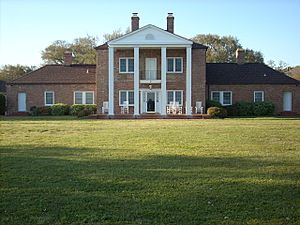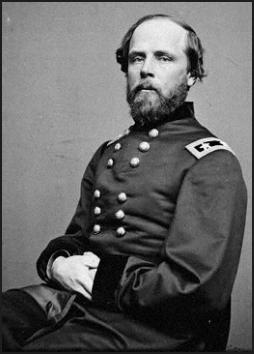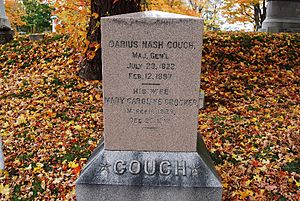Darius N. Couch facts for kids
Quick facts for kids
Darius Nash Couch
|
|
|---|---|
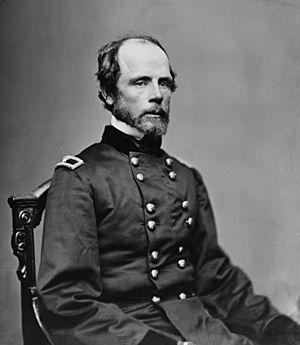
Portrait of Darius Couch by Mathew Brady or Levin C. Handy taken in 1861 or 1862
|
|
| Born | July 23, 1822 Putnam County, New York, US |
| Died | February 12, 1897 (aged 74) Norwalk, Connecticut, US |
| Place of burial | |
| Allegiance | United States of America Union |
| Service/ |
United States Army Union Army |
| Years of service | 1846–1855, 1861–1865 |
| Rank | |
| Commands held | II Corps, Army of the Potomac Department of the Susquehanna 2nd Division, XXIII Corps |
| Battles/wars | Mexican–American War Seminole Wars American Civil War |
| Signature | |
Darius Nash Couch (born July 23, 1822 – died February 12, 1897) was an American soldier, businessman, and naturalist. A naturalist is someone who studies nature. He served as an officer in the U.S. Army during the Mexican–American War and the Second Seminole War. He also became a general officer in the Union Army during the American Civil War.
During the Civil War, Couch fought in important battles like the Peninsula and Fredericksburg in 1862. He also fought in the Chancellorsville and Gettysburg campaigns in 1863. He rose to lead a large group of soldiers called a corps in the Army of the Potomac. He also led smaller groups called divisions in both the Eastern and Western parts of the war. Soldiers under his command played a key role during the Gettysburg Campaign. They helped slow down the Confederate troops, stopping them from crossing the Susquehanna River. This was very important for Pennsylvania's defense.
People described him as brave and very thin. After his time in Mexico, he often had poor health.
Contents
Early Life and Army Start
Couch was born in 1822 on a farm in Southeast, Putnam County, New York. He went to local schools there. In 1842, he joined the United States Military Academy at West Point. He graduated four years later, ranking 13th out of 59 students. On July 1, 1846, Couch became a brevet second lieutenant. This was a temporary rank, and he was assigned to the 4th U.S. Artillery.
Couch then fought in the Mexican–American War. A notable battle was the Battle of Buena Vista in February 1847. For his brave actions there, he earned a temporary promotion to first lieutenant. After the war ended in 1848, Couch served at military bases. These included Fort Monroe in Hampton, Virginia, and Fort Pickens near Pensacola, Florida. He also served in Key West. Couch then took part in the Seminole Wars from 1849 to 1850.
He returned to regular army duties. He was sent to Fort Columbus in New York Harbor in 1850. In 1851, he helped recruit soldiers at Jefferson Barracks in Lemay, Missouri. Later that year, he was at Fort Columbus again. Then he went to Fort Johnston in Southport, North Carolina, until 1852. His next post was Fort Mifflin in Philadelphia until 1853.
Couch took a year off from the army from 1853 to 1854. He went on a science trip for the Smithsonian Institution in northern Mexico. There, he discovered new animal species. Two of these were named after him: Couch's kingbird (a type of bird) and Couch's spadefoot toad (a type of frog). When he returned to the United States in 1854, he worked in Washington, D.C.. Later that year, he was back on duty at Fort Independence in Boston Harbor, Massachusetts. He also served at Fort Leavenworth, Kansas, until 1855. On April 30, 1855, Couch left the U.S. Army. From 1855 to 1857, he was a merchant in New York City. He then moved to Taunton, Massachusetts. There, he worked with copper in his wife's family business. Couch was still working in Taunton when the American Civil War began in 1861.
American Civil War Service
Early War Years
When the Civil War started, Couch was made commander of the 7th Massachusetts Infantry on June 15, 1861. He held the rank of colonel in the Union Army. In August, he was promoted to brigadier general. That fall, he was given command of a brigade in the Army of the Potomac. The next spring, he led a division in the VI Corps. From July 1861 to March 1862, he helped train soldiers. He also worked to defend Washington, D.C.. He took part in the Peninsula Campaign. He fought in the Siege of Yorktown from April 5 to May 4. He also fought in the Battle of Williamsburg the next day.
Seven Pines Battle
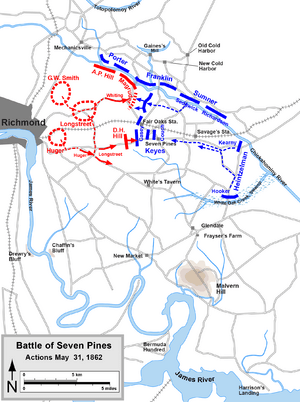
Couch led his division during the Battle of Seven Pines on May 31 and June 1, 1862. In this battle, his corps commander ordered Couch's division and another division to move forward. This put them in a dangerous spot, open to attack from three sides. However, the Confederate movements were not well organized. This allowed Couch and the other commander to prepare some defenses. As the fighting continued, Couch's men were slowly pushed back. Their right side was in the most danger. Couch tried to fight back with his old 7th Massachusetts Infantry. But he was forced to retreat, along with the rest of the Union IV Corps.
Couch continued to lead his division during the 1862 Seven Days Battles. He fought in the Battle of Oak Grove on June 25 and the Battle of Malvern Hill on July 1. Later in July, Couch's health began to get worse. He offered to resign from the army. But the army commander, Maj. Gen. George B. McClellan, refused. Instead, Couch was promoted to major general on July 4. Couch was involved in the Maryland Campaign that fall. However, he was not present at the Battle of Antietam on September 17.
Fredericksburg Battle
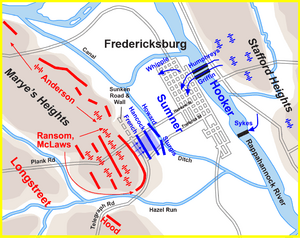
On November 14, 1862, Couch was given command of the II Corps. He led it during the Battle of Fredericksburg. His corps had three divisions. On December 12, his soldiers tried to help Union engineers build pontoon bridges across the Rappahannock River. But Confederate fire kept stopping them. Small groups of soldiers then crossed in boats to push back the defenders. One of Couch's brigades succeeded in driving out the Confederates.
When Union soldiers entered Fredericksburg, they started taking things from the city. Couch had to order his military police to stop them. The next day, his corps was ordered to attack the Confederate position. This was at the base of Marye's Heights above Fredericksburg. Couch climbed to the top of the town's courthouse to watch. He saw his men facing very heavy fire and being pushed back easily. He described it "as if the division had simply vanished." Other divisions followed, suffering many casualties. Couch saw the heavy losses. He reportedly said, "Oh, great God! See how our men, our poor fellows, are falling."
Couch ordered his artillery to move closer and fire at the Confederates. His own artillery chief worried about the danger to the gun crews. But Couch said it was needed to slow the enemy fire. The cannons fired from about 150 yards away. But they quickly lost most of their crews and did not stop the enemy much. Couch moved along his line of men, who were firing until nightfall. After the war, Couch wrote about the attack. He said the firing was "simply terrible." He reported that his II Corps had over four thousand casualties during the Fredericksburg Campaign. Many soldiers died from wounds and the cold.
Chancellorsville Battle
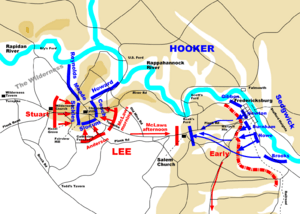
After the Union loss at Fredericksburg, the commander of the Army of the Potomac was replaced. Maj. Gen. Joseph Hooker took command. Hooker planned a new campaign. He wanted to avoid attacking the strong Confederate defenses at Fredericksburg. Instead, he wanted to move around them and fight on more open ground. Couch continued to lead the II Corps. His corps had about 17,000 soldiers.
During the Chancellorsville Campaign, Couch was the most senior corps commander. This made him Hooker's second-in-command. In late April, Hooker began moving his corps across the Rappahannock and Rapidan Rivers. Couch's divisions were ordered to defend a river crossing. On May 1, Hooker, who was usually aggressive, became very cautious. He stopped the army's movement, even though they were having some success. Couch sent a division to help. He told Hooker they could handle the enemy. But Hooker's orders stood: retreat to their previous positions and defend. Couch obeyed. He ordered his division to form a rear guard as they pulled back. Couch saw Confederate artillery aiming at the Union soldiers. He told his staff, "Let us draw their fire." They stood in a clearing to attract the enemy fire, saving the marching infantry. By nightfall, the Union soldiers were building defenses.
On May 2, the Confederate army attacked the Union line. The Union XI Corps was routed and ran back. By May 3, the remaining corps formed a "U" shape. Confederate artillery began shelling their positions. Around 9 a.m. that day, Hooker was hit by enemy fire. A shell hit the pillar he was leaning on, making him unable to command. Hooker then gave command of the army to Couch. After talking with a "groggy" Hooker, they decided to pull the army back to new defensive lines.
Gettysburg Campaign
Couch asked to be moved to a different command after disagreeing with Hooker. President Abraham Lincoln offered him command of the Army of the Potomac. But Couch said no, citing his poor health. He then commanded the new Department of the Susquehanna during the Gettysburg Campaign in 1863. Fort Couch in Lemoyne, Pennsylvania, was built under his direction and named after him. This fort was meant to protect Harrisburg from a threatened attack by Confederates. Couch directed his militia (citizen soldiers) to fight with enemy cavalry at Sporting Hill. This was one of the northernmost battles of the war. Couch's militia then joined the chase after Robert E. Lee's Army of Northern Virginia into Maryland after the Battle of Gettysburg.
Later War Service
Confederates invaded Couch's area again in August 1864. They burned the town of Chambersburg. In December, Couch returned to the front lines. He was assigned to the Western Theater of the war. He commanded a division in the XXIII Corps of the Army of the Ohio. He served in the Franklin-Nashville Campaign and for the rest of the war. Couch finished his military service after the Carolinas Campaign in 1865.
After the War and Death
After the war, Couch returned to civilian life in Taunton. He ran for Governor of Massachusetts in 1865 as a Democratic candidate, but he lost. He later briefly served as president of a mining company in West Virginia. In 1871, Couch moved to Connecticut. There, he served as the Quartermaster General and then Adjutant General for the state militia until 1884. In 1888, he joined the Aztec Club of 1847, a group for Mexican War veterans. He also joined the Connecticut Society of the Sons of the American Revolution in 1890.
Darius Couch died in Norwalk, Connecticut. He was buried in Mount Pleasant Cemetery in Taunton.
Legacy
Darius Couch is remembered as a skilled commander of divisions and corps in the Army of the Potomac. He sometimes showed impatience and temper. He also had long periods of poor health, which led him to take on less demanding roles.
In 2017, a mural in Lemoyne, Pennsylvania, featured General Couch's portrait. This honored the defenses built in the town under his name during the Gettysburg campaign. The fort served as the last defense for Pennsylvania's capital city, Harrisburg.
Couch is also honored in the scientific names of several animals. Two types of reptiles are named after him: Sceloporus couchii and Thamnophis couchii. One frog, Scaphiopus couchii, is also named for him. And a bird species, Couch's kingbird, carries his name.


